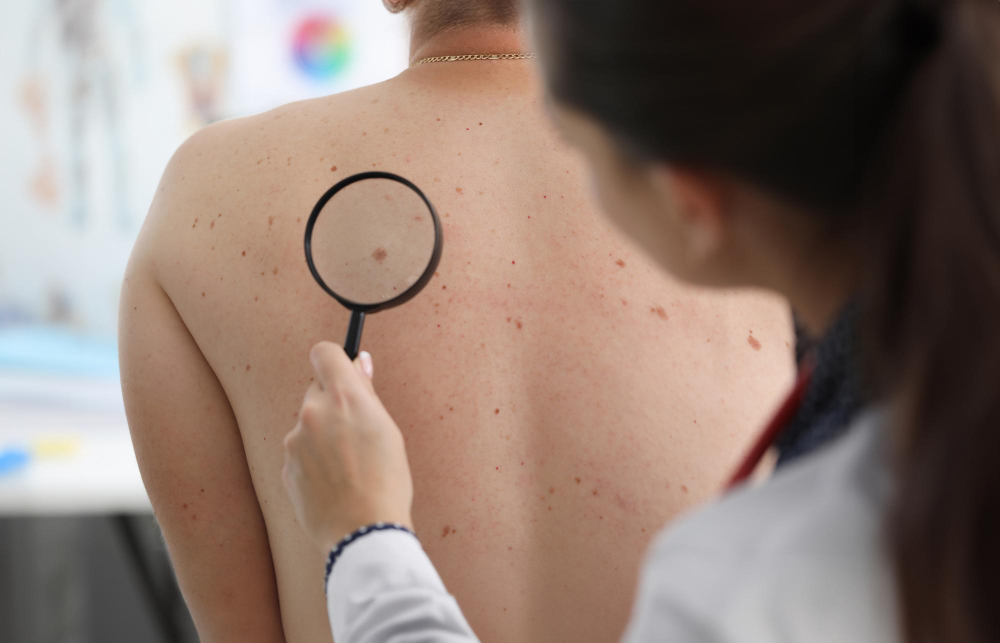Skin cancer is a rampant health issue worldwide and can affect anyone, regardless of age or race. Skin cancer symptoms often appear subtle at first, which can lead to a late diagnosis. However, if detected early, the outlook for treatment and recovery is much brighter. Early detection of skin cancer symptoms means observing small changes in your skin that might go unnoticed. Sometimes these changes are mistaken for harmless conditions. Learning to recognize these symptoms early can be lifesaving.
Early signs like persistent sores or confusing moles can be clues. By staying alert and informed, you empower yourself to take timely action, shielding yourself and your loved ones against severe risks.
Understanding Skin Cancer: Essential Knowledge
Skin cancer is when abnormal cells grow uncontrollably in your skin, leading to various health issues. It affects millions and is a serious concern worldwide. Here, we’ll cover different types of skin cancer and what they usually look like.
- Basal Cell Carcinoma: This is the most common type. It often appears as a transparent bump on the skin but can also manifest as red or pink spots. Though it rarely spreads, it’s crucial to treat it early.
- Squamous Cell Carcinoma: This type is often seen as red, scaly patches or open sores. Like Basal Cell, it can affect people of all colors, though it’s more aggressive.
- Melanoma: Known as the most serious type, it can spread quickly. It’s crucial to look for mole changes like size, shape, or color. Common early signs of skin cancer include existing moles that turn asymmetrical or develop uneven borders.
Skin cancer symptoms are seen globally, but places like India report rising cases. It is often curable if caught early, but recognizing the early signs of skin cancer** is essential to ensure prompt treatment.
Recognizing Early Symptoms and Encouraging Prompt Medical Attention
Let’s dive into some early signs of skin cancer that help you detect trouble early: – Unusual growths: Look for new spots or patches on your skin, especially if they change color or texture. – Non-healing sores: If a sore doesn’t heal after weeks, it might need a check-up. – Changes in moles: Sudden changes in mole appearance can indicate melanoma.
To distinguish benign changes from dangerous ones, consider this comparison:
A benign skin change typically remains consistent in size over time, while a potential cancerous lesion may grow rapidly. Benign growths are usually symmetrical in shape, whereas cancerous spots tend to be asymmetrical. The color of a benign skin change is usually even, while potential cancer symptoms may display multiple colors or shades. Texture is another distinguishing factor: benign changes are generally smooth and harmless, whereas cancerous lesions may be rough or scaly. Lastly, the border of a benign skin change is typically well-defined, while that of a potential cancerous growth is uneven or blurred.
Consider the ABCDE rule for spotting melanomas: – A – Asymmetry: One half doesn’t match the other. – B – Border: Edges are irregular, ragged, or blurred. – C – Color: Color isn’t uniform; may include shades of black, brown, and tan. – D – Diameter: The spot is larger than a pencil eraser. – E – Evolving: The spot changes in size, shape, or behavior over time.
Regular skin self-exams can help catch skin cancer symptoms early. Here’s how to do it: – Find a well-lit room with a full-length mirror. – Start at your face, and work down your body, checking every part. – Use a hand mirror for hard-to-see areas like your back and scalp.
If you spot anything unusual, consult a healthcare professional for more thorough skin cancer detection methods.
Proactive Prevention and Affordable Solutions for Managing Skin Cancer Risks
Protecting your skin can reduce the skin cancer causes like sun exposure. Here are simple tips: – Sunscreen Use: Apply SPF 30 or higher when going outside, reapply often. – Clothing: Wear hats and sunglasses for extra protection. – Shade: Stay out of direct sunlight, especially between 10 a.m. and 4 p.m.
Regular self-checks are crucial. Make it a monthly habit to review your skin surface, looking for any skin cancer symptoms.
In places like India, many health resources are now focusing on affordable screening and skin cancer treatment options. Free clinics and awareness programs can make a huge difference in skin cancer detection methods and accessibility. Interestingly, scientific advances like AI are making skin cancer detection methods quicker and more accurate. These tools help doctors identify potential issues faster, enhancing prevention efforts.
In conclusion, staying mindful of skin cancer symptoms and proactively checking your skin can significantly impact your health. With continued education and evolving medical resources, everyone can take steps toward prevention. By understanding skin cancer causes and recognizing the differences between skin cancer types, you are better positioned to act early, ensuring a healthier future for yourself and your loved ones.

